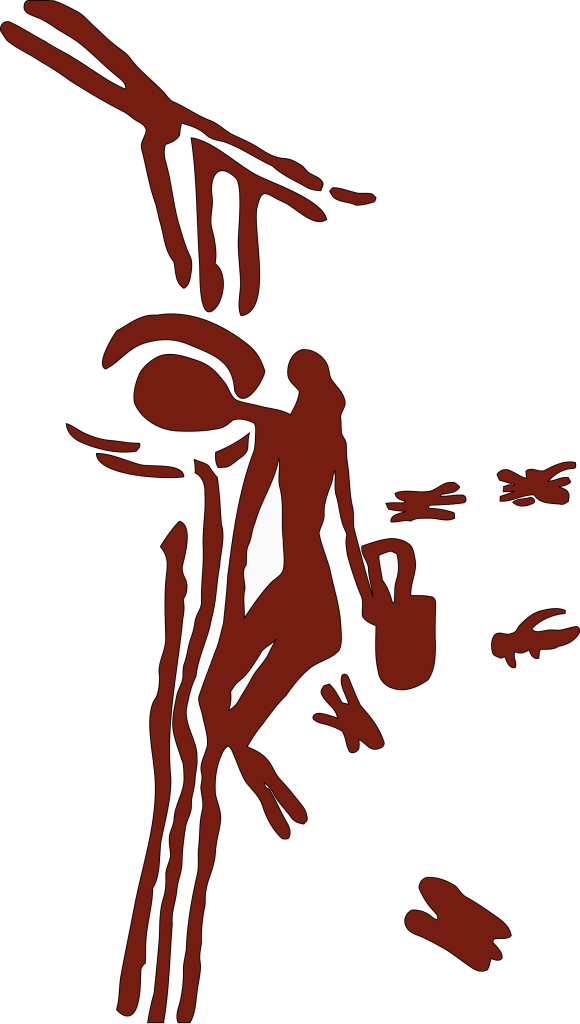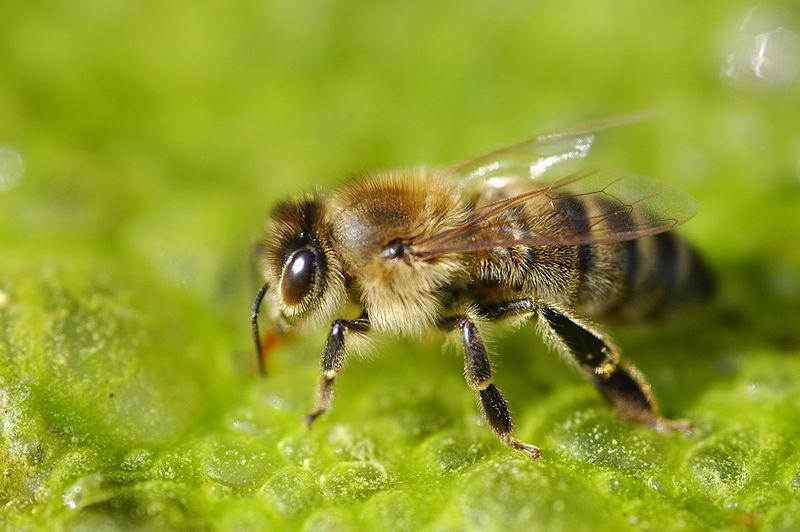By Sean Fagan.

Drawing of a 8,000 year old rock painting depicting a honey hunter harvesting honey from a bees nest in a tree. This painting is located in the Arana caves, Valencia, Spain (photo: Wikimedia commons).
Learn The Story of How Honey is Made
and
5 Outdoor Uses of Honey
.
.
Introduction
.
Honey is a fascinating, natural substance.
A delicious, viscous golden liquid incredulously created by a few social insects (i.e. bees, wasps and bumblebees).
But it’s the honeybees, of the Apies genus, that excel in making large quantities of high quality honey.
Right across the globe, wherever honey bees occur, humans have fostered a special relationship with honey.
.
In this article, learn how honey is made.
Also discover 5 outdoor uses of honey, and why you should consider bringing some honey on your next outdoor excursion.
HOW HONEY IS MADE
.
Deep in the dark cosy sanctuary of every honey bee hive, within sealed chambers that hang from the hive ceiling, are deposits of honey.
Hive honey is a precious repository of energy-rich food for bees, especially during winter in temperate regions, when flowering plants - their main food source, are not in bloom.
The story of how honey is made is remarkable process.
Honey starts out as nectar – the slightly sweet, watery fluid found at the base of most flowers. Flowers produce nectar to entice bees to visit their flowers to facilitate cross-pollination.
Once a collecting bee has enough nectar (they store the nectar in a 2nd stomach) they return to the hive, and regurgitate the nectar so worker bees can begin the processes of converting nectar into honey.
At this stage, the unprocessed nectar is a clear liquid composed of 80% water with the remainder composed mostly of complex sugars.
The first stage of processing occurs when the worker bees digest the raw nectar, to break down the complex sugars of the nectar into a simple sugar.
They then spread the processed nectar into honey chambers to dehydrate, thereby significantly reducing the water content.
In order to hasten the drying of the honey, bees will often create a draft with their wings to dry out the honey.
What started out as watery fluid which contained complex sugars, has been processed into a simple sugar food with a much reduced water content.
Its remarkable to think of an innocuous fluid - nectar, found at the base of flowers is miraculously transformed, by an industrious insect, into a sweet liquid of a transparent, golden hue.
And that honey, enjoyed by so many people, has resided temporarily in the stomachs of both worker and foraging honey bees, was gently fanned by insect wings to dry out so as to provide a precious source of nourishment and energy for many bees and their larvae.
It’s an dynamic, multi-species journey: flower to bees, and often, ultimately - from beehive to humans.
“The bee, from her industry in the summer, eats honey all the winter”
Proverb
.

Weighing, on average, only one tenth of a gram, its hard to believe that this small insect can visit between 50-100 flowers and can carry half its weight in pollen and nectar - on each collection trip (photo: Wikimedia commons).
.
.5 Outdoor Uses of Honey
.. 1. PROMOTES HEALING OF CUTS, SCRAPES & BURNS
. The high sugar content, and other antibacterial properties of honey, prevent infection.
Also, honey is sticky. Simply smearing sticky honey onto a cut will form a good, sealed barrier against external infection.
Preventing infection on small cuts, scrapes and (superficial) burns might seem like a moot point when outdoors but it’s an important facet of outdoor living especially when living in warm, humid environments (such as the tropics) as high humidity and warm temperatures are the perfect breeding grounds for skin infections to take hold.
Honey can also be used as a gargle for sore throats.
There is evidence that the quality of honey is important when using honey to treat small skin wounds. If in doubt, medicinal honey is recommended. An example of medicinal honey is Manuka honey, from New Zealand.
Of course I'm not condoning having honey at the expense of carrying a proper, outdoor first-aid kit.
It's just nice to have an alternative, like honey.
. 2. TRAP BAIT
. A lot of survival situations can be greatly alleviated, when practical and necessary, with sourcing nutritious, calorie-dense food sources such as wild meat.
Honey is a very sweet and natural substance that can be detected by many wild animals (due to their well developed sense of smell).
Often honey is indigenous to many wild areas so the scent of honey will not be alien to many animal species.
Smearing a little honey onto a trap could be the extra incentive in encouraging a wild animal into a trap.
(*I'm not advocating, in any form, recreational trapping of wild animals. What I am advocating, is that trapping - while in a survival situation can, depending on circumstances, be justified).
.3. HONEY ADDS A NICE ZING TO OUTDOOR FOOD
.
One of the potential, detrimental aspects of outdoor living is consuming a monotonous diet.
There seems to be a natural human craving for the occasional sweet treat in our diets.
Flavouring food well can be a surprisingly important part of keeping up morale, especially on extended outdoor trips.
Salt, pepper, herbs and various spices are all standard and much-valued ways of flavouring food when outdoors.
Adding a little honey to our outdoor flavouring stockpile can add a nice zing to many outdoor dishes.
For example, smearing some honey onto roasting meat is a delicious way to flavour meat.
Honey can also be used to flavour bread that is baked while outdoors.
As an outdoor tea, honey is delicious (in my opinion). Simply stir some honey into hot water and you have a hot, energy-rich drink.
Evolutionary, bees created honey in order to have a nutritious food source that would last through the winter when flowers are generally absent. It was created to last - to be non-perishable, for at least a few months.
Processed honey, which has had most of its spoiling impurities removed, lasts even longer than unprocessed hive honey.
Bringing food on bushcraft/camping trips that lasts a long time is an advantage, especially in warmer climates where a lot of food tends to spoil quickly.
.4. EMERGENCY ENERGY SURGE
. In an emergency situation, a surge of energy is often desired to amp up flagging energy levels to perform a vital task.
With some medical conditions, like hypothermia, the body often craves simple sugars to generate much-needed metabolic heat to stave off a further drop in core temperature.
A person with type two diabetes experiencing a serious drop in blood sugar levels can be alleviated with ingesting honey. Since honey is often soft and runny, it requires no mastication (chewing) on behalf of a diabetic to digest, which can be helpful if the diabetic is sluggish and having difficulty chewing sugary foods such as sweets or a chocolate bar or cannot safely drink a hot, sugary drink.
Simply smearing a little honey on the inside of the lower lip is often enough to revive the diabetic person (the sugar quickly passes into the bloodstream through the tongue and lining of the mouth).
Once, I was in the unfortunate position of reviving a person slipping into diabetic shock.
Myself and another person managed to revive the person by partially chewing a slice of pear and placing the mashed up pear into the causalities mouth. Thankfully, within about 5 minutes, the person started to recover.
It would have been a simpler procedure to place some honey into the mouth of the causality to facilitate an even quicker recovery.
Lesson learned.
Making that final effort to get back to civilisation in a survival situation or even tackling the arduous task of creating an essential shelter when low on sugar is daunting. Putting some sugar in your system can give you a much needed edge to travel back to safety or complete an essential, survival task.
This is partially why - chocolate bars, sugary sweets and sugary energy drinks are often stashed in many outdoor first-aid kits, because sugar is important when a boost of energy and mental clarity is required (the brain is a very sugar-hungry organ).
Who would ever think that a simple food, like honey, could potentially help save a life?
5. PREVENTING LOW BLOOD SUGAR
. Aside from life-threatening scenarios, having a food that is sugar-rich can provide a nice energy surge when performing arduous tasks such as hiking - so as to avoid a dip in blood-sugar levels.
Many endurance athletes often consume thousands of sugar calories when competing in arduous endurance events.
In professional cycling, there is term called ‘bonking’, which occurs when a cyclist has inadvertently forgotten or cannot access sugar calories when cycling in a race.
Hypoglycaemia, i.e. abnormally low blood sugar is often caused when prolonged exertion far exceeds ingestion of calories.
Hypoglycaemia causes a whole slew of worsening symptoms to occur such as a drastic drop in energy, blurry vision, shaking, weakness and nausea.
When cyclists are experiencing hypoglycaemia and receive sugar - they are usually quickly revived.
I don’t mean to superficially cast general outdoor enthusiasts and people who practise bushcraft in the same light as professional cyclists but when you think about it – a hard half-day or full-day mountain hike, for example, has elements of an arduous, endurance event.
I like to put two teaspoons of honey into a 750ml flask of green tea when hiking (I also carry water in a separate container).
The hot tea provides a much appreciated source of internal heat during cold days on the mountains, and the honey ensures that my blood-sugar is topped up.
When performing an arduous physical activity for a lengthy period of time it's beneficial to supply a hard-working body with a source of easily digestible, sugary food - such as honey.
The bottom line is that prolonged low blood sugar can seriously affect morale, good judgement, energy levels and physical performance.
Besides, honey is generally regarded as a health food… Just ask the bees : ) . Related articles on this website: References & Useful Links:- International Bee Research Association (includes excellent PDF leaflet on bees)
- How to Verify the Purity of Honey
- Definition of Type 2 Diabetes (Mayo Clinic)
- The Arana caves
BONUS BEE FACTS
.
Honey is the only food product created by an insect that humans eat.
There were 2,000 year old vats of sealed honey found in King Tut’s tomb. The honey is believed to be still edible.
To produce a single 500g jar of honey foraging bees have to travel the equivalent of three times around the world.
Cotton soaked in honey and lemon juice has been used as a contraceptive in Egypt for 2,000 years.
Queen bees live on average 2-3 years while worker bees, during the summer, live on average, 3 weeks.
PIONEER BUSHCRAFT DISCLAIMER
.
The aim of this article is to provide advice that will enhance the quality of your time, and well-being, when outdoors.
Pioneer Bushcraft does not take any responsibility for the misapplication of advice in this article.
The advice in this article is very much an adjunct to, and not a substitute for, high-quality bushcraft training (including outdoor medical training), relevant research and experience, trustworthy local knowledge, a thorough risk assessments and all other health & safety considerations specific and pertinent to your outdoor excursions.
When outdoors, take responsibility for your well being seriously.
It can make all the difference between a great or bad outdoor experience.

Recent Comments